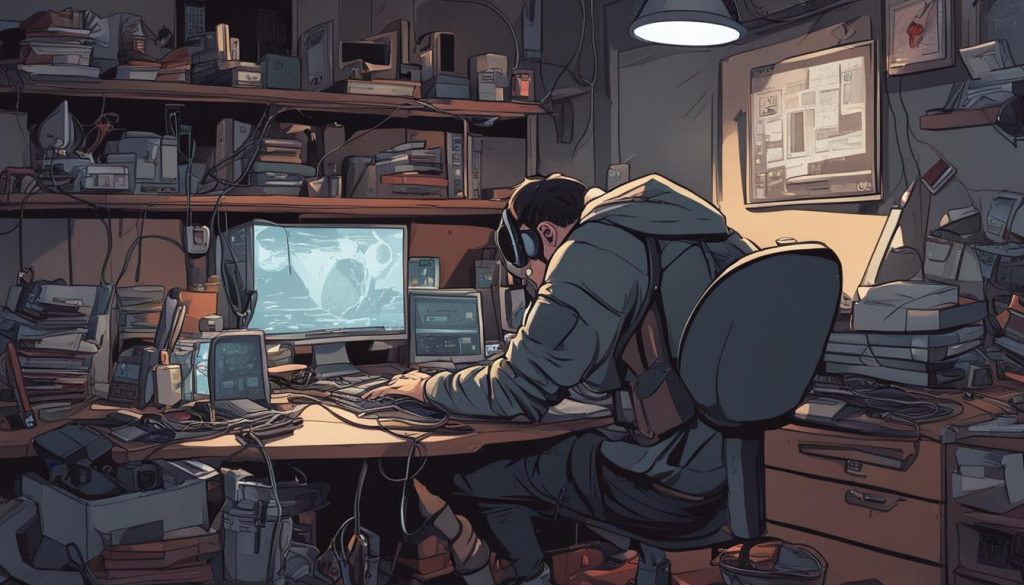In today’s interconnected world, our constant exposure to screens and technology can take a toll on our mental and physical well-being. The concept of a digital detox has gained popularity as a way to mitigate these effects and promote overall wellness. By taking a break from technology, individuals can experience various benefits that positively impact their health and lifestyle.
Key Takeaways:
- Digital detoxing can have a significant impact on mental and physical well-being.
- Reduced screen time can lead to improved sleep quality and reduced stress.
- Disconnecting from technology can enhance focus and productivity.
- Different types of digital detoxes, such as social media detox and screen time detox, offer various ways to limit digital exposure.
- Incorporating digital detoxing into our daily lives can prioritize mental well-being and foster meaningful connections with others.
The Negative Effects of Digital Overload

Constant exposure to screens and technology can have detrimental effects on our health and well-being. Excessive screen time can lead to various physical health issues such as eye strain, headaches, neck and back pain, and disrupted sleep patterns. Additionally, the constant connectivity and digital stimulation can take a toll on our mental health. Research has shown that it can contribute to anxiety, depression, and other mood disorders.
Moreover, the constant use of technology can make it difficult to focus on important tasks, reduce productivity and creativity, and impact our social lives by decreasing face-to-face communication skills and increasing social isolation. It is important to recognize these negative effects and consider the benefits of digital detoxing to prioritize our overall well-being.
“Technology is a useful servant but a dangerous master.” – Christian Lous Lange
As mentioned earlier, excessive use of technology can lead to a wide range of negative effects. Let’s take a closer look at each:
Physical Health Issues
The constant exposure to screens can result in eye strain, which leads to dry and irritated eyes, blurred vision, and headaches. Sitting for extended periods in front of screens also contributes to neck and back pain. Moreover, the blue light emitted by screens can disrupt our sleep patterns, making it harder to fall asleep at night and leading to poor sleep quality.
Mental Health Challenges
Continuous digital stimulation can have a significant impact on our mental well-being. Studies have shown that excessive screen time can contribute to anxiety, depression, and other mood disorders. The constant exposure to social media platforms and digital content can lead to feelings of inadequacy, comparison, and FOMO (fear of missing out), affecting our self-esteem and overall mental health.
Impact on Productivity and Social Life
The constant use of technology can also hinder our ability to focus on important tasks. Distractions such as notifications, social media, and endless online content can reduce productivity and creativity. Additionally, as digital communication becomes more prevalent, face-to-face interaction and social skills can suffer, leading to social isolation and a lack of meaningful connections.
To help illustrate the negative effects of digital overload, here is a table summarizing these detrimental impacts:
| Negative Effects | Description |
|---|---|
| Physical health issues | Eye strain, headaches, neck and back pain, disrupted sleep patterns |
| Mental health challenges | Anxiety, depression, other mood disorders |
| Impact on productivity | Reduced focus, decreased productivity and creativity |
| Impact on social life | Social isolation, decreased face-to-face communication skills |
As we can see, the negative effects of constant digital stimulation and the impact of technology on mental health are significant. It is crucial to be mindful of our technology use and consider the benefits of digital detoxing to prioritize our overall well-being.
By recognizing the negative effects and taking steps towards reducing screen time and finding a healthy balance, we can improve our physical and mental health, foster meaningful connections, and create a more balanced lifestyle.
What is a Digital Detox?

A digital detox involves intentionally disconnecting from technology for a specific period of time. It can range from a few hours to a few days or more, depending on individual preferences and goals.
Various types of digital detoxes exist, each targeting specific aspects of technology use. Let’s explore some of the most commonly practiced digital detoxes:
- Social Media Detox: This detox focuses on taking a break from social media platforms such as Facebook, Instagram, and Twitter. It has been found to reduce anxiety, improve sleep, and increase productivity.
- Smartphone Detox: This involves reducing or eliminating the use of smartphones. By taking a break from constant digital connectivity, individuals can reduce feelings of FOMO (fear of missing out), improve relationships, and increase mindfulness.
- Screen Time Detox: This detox aims to reduce the time spent in front of screens, including TVs, computers, and smartphones. It can lead to reduced eye strain, improved sleep, and increased productivity.
- Internet Detox: An internet detox involves taking a break from the internet altogether. By disconnecting from email, social media, and online news, individuals can reduce feelings of overwhelm and improve mental clarity.
- Digital Declutter: This detox involves organizing and decluttering digital files and subscriptions. By reducing digital clutter, individuals can alleviate feelings of overwhelm and increase productivity.
Each type of digital detox offers unique benefits and can be tailored to individual needs. Whether it’s taking a break from social media, reducing screen time, or decluttering digital files, there’s a digital detox approach for everyone.
The Benefits and Downsides of a Digital Detox
A digital detox can have numerous benefits for mental health and overall well-being. Disconnecting from technology can help reduce stress and anxiety, improving mental health and well-being. It can also lead to increased productivity and creativity by improving focus and concentration. Additionally, taking a break from screens before bed can improve sleep quality and quantity by reducing exposure to blue light. Spending less time online can also promote face-to-face interactions and improve communication skills, ultimately enhancing social connectedness.
On the other hand, it is important to acknowledge the potential downsides of a digital detox. One of the main downsides is the risk of missing out on important news or communication with friends and family. Technology has become a primary mode of communication and staying informed, so disconnecting may require finding alternative ways to stay connected and informed.
Another challenge is breaking old habits and routines associated with technology use, which may cause feelings of anxiety or boredom. However, the benefits of digital detoxing often outweigh the potential downsides, and by setting boundaries and finding alternative ways to stay connected, individuals can make the most of their digital detox experience.
| Benefits of Digital Detoxing | Downsides of Digital Detoxing |
|---|---|
| Improved mental health and well-being | Risk of missing out on important news and communication |
| Increased productivity and creativity | Breaking old habits and routines |
| Better sleep quality | Feelings of anxiety or boredom |
| Enhanced face-to-face communication skills |
Note: The benefits of digital detoxing significantly outweigh the potential downsides. By setting boundaries and finding alternative ways to stay connected, individuals can make the most of their digital detox experience and prioritize their mental health and well-being.
Conclusion
Incorporating a digital detox into our daily lives can have a transformative impact on our mental and physical well-being. By consciously setting specific time periods to disconnect from technology, such as turning off our phones or avoiding social media, we can create healthy boundaries and promote a more balanced lifestyle.
During a digital detox, it is important to be patient with ourselves and allow time to adjust to the absence of technology. This process may initially feel challenging, but the benefits are well worth it. Disconnecting from technology offers a range of advantages, including improved mental health and overall well-being, increased productivity and creativity, better sleep quality, enhanced face-to-face communication skills, and the opportunity to engage in offline activities that bring joy and fulfillment.
While there may be potential downsides and challenges associated with a digital detox, the rewards of reconnecting with the world around us far outweigh the risks. By prioritizing our mental well-being and making conscious choices about our technology use, we can rejuvenate our mind and body, leading to a healthier and more balanced lifestyle.
FAQ
What is a digital detox?
A digital detox involves intentionally disconnecting from technology for a specific period of time.
What types of digital detoxes are there?
There are various types of digital detoxes, including social media detox, smartphone detox, screen time detox, internet detox, and digital declutter.
What are the benefits of a digital detox?
A digital detox can lead to reduced stress, improved sleep quality, enhanced focus, increased productivity, and better mental health and overall well-being.
Are there any downsides to a digital detox?
Some potential downsides of a digital detox include missing out on important news or communication and the challenge of breaking old habits and routines associated with technology use.
How can I incorporate a digital detox into my daily life?
You can incorporate a digital detox into your daily life by setting specific time periods for disconnecting from technology and finding alternative ways to stay connected and informed.

